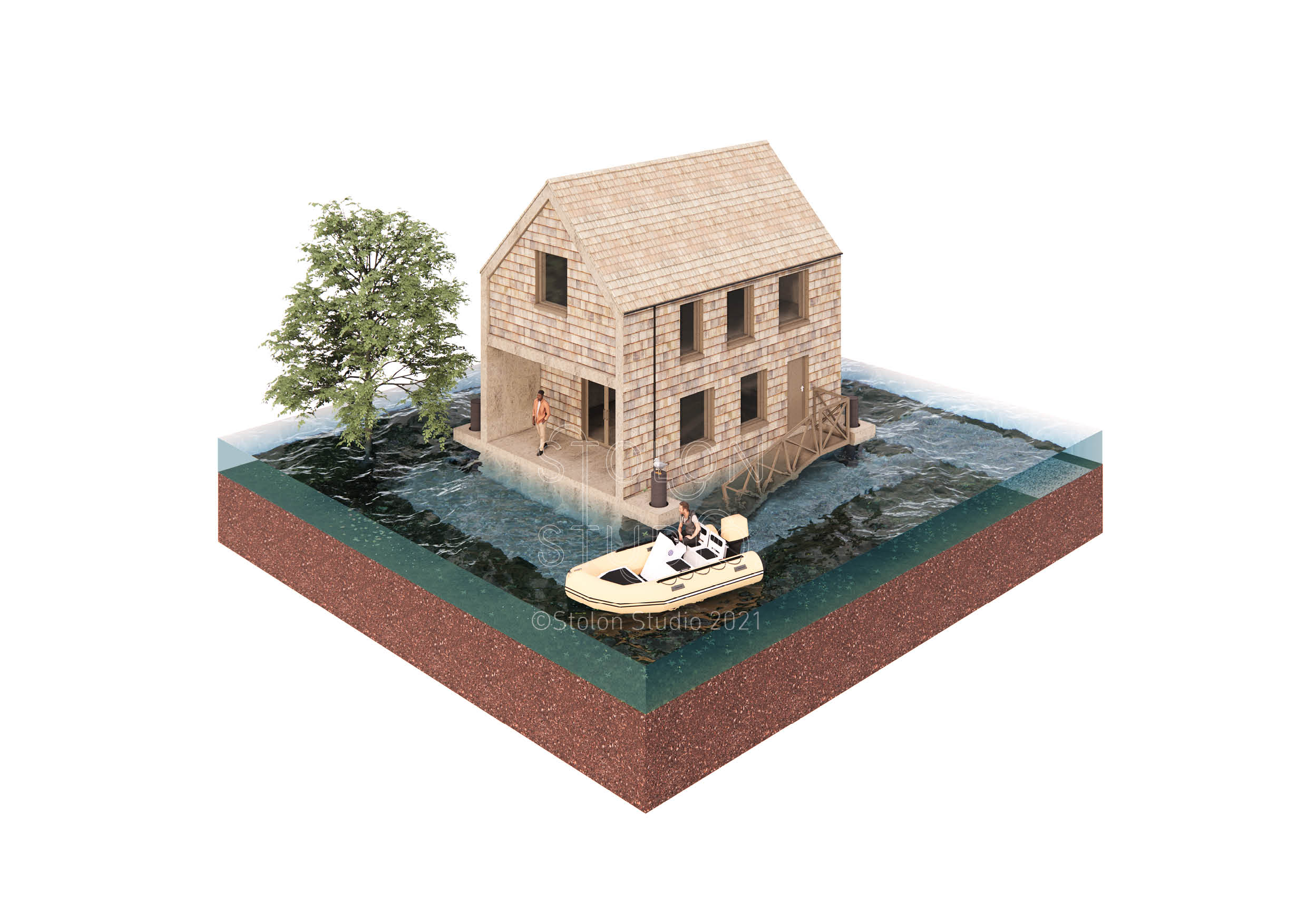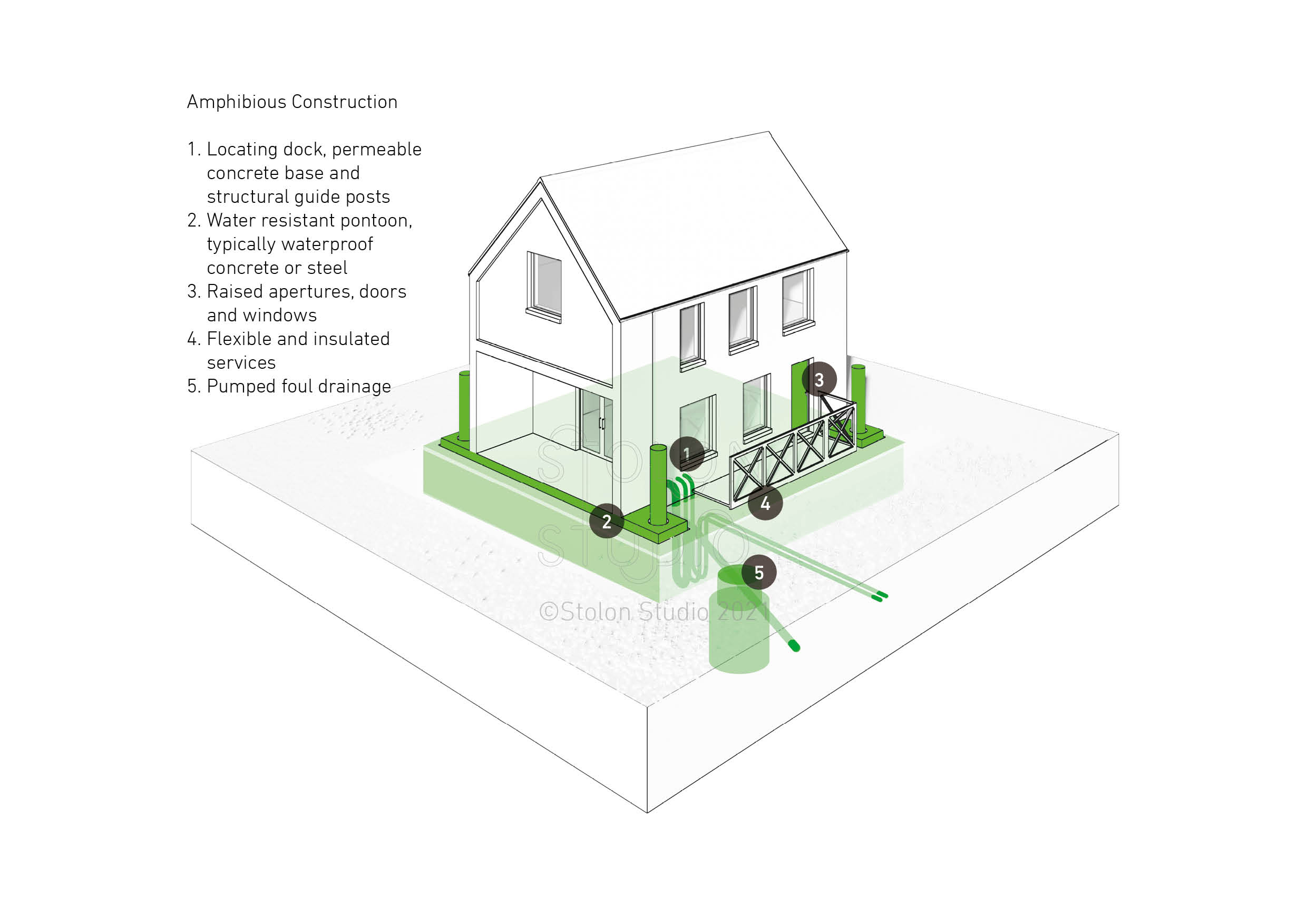Amphibious Construction
An amphibious building, or can-float building, is one that is designed to float in the event of a flood, but to rest on solid foundations at other times. This unusual hybrid building typology has an express purpose to protect the property from flooding by floating when water levels rise.
Amphibious buildings are typically designed as to be conventional fixed buildings but constructed with technology also used in floating buildings. They are not designed to float continuously, instead, they float when flood levels reach a certain level, hence the alternative name - can-float.
To make any object float it requires buoyancy. As buildings are heavy, water levels need to be sufficient to provide the buoyancy to enable them to float.
Unlike a floating home which requires a permanent deep body of water, an amphibious house only needs to float when water levels rise, and reach the sufficient depth to provide buoyancy, i.e. during a flood. This means that an amphibious building may be bigger and heavier than a floating one, which may be limited in size by the depth of water.
Most amphibious buildings use a concrete pontoon base, rather like the hull of a boat, where the height of the pontoon is determined based on the level of water required to make the structure buoyant. From experience a single storey height concrete pontoon can support a light weight 2 storey building above. This has the added advantage that the space within the pontoon can be used as accommodation rather like a traditional basement.
Steel pontoons, which are lighter than concrete pontoons, may support larger buildings than those using similar sized concrete pontoons. However, in addition to buoyancy the issue of balance must be considered. A boat is made stable by its keel. A floating structure is reliant on maintaining a low centre of gravity. The heavier the base the lower the centre of gravity. Therefore, a building supported by a steel, plastic or timber pontoon may be less stable than a concrete one.
A further consideration is the tethering. Whilst a floating structure can rise and fall, held roughly in place by a mooring post, like a boat; this may not be suitable for a building where it may need to land in exactly the same place that it floated from. In this situation, complicated control measures may be required to restrain the structure.
Whilst there are other issues, the most challenging is servicing. Like a moored boat: electricity, water, waste, and telecom connections need to be flexible. This in itself is not complicated but the distance of travel during a flood can be substantial, so the location of pipes needs to be carefully considered. From experience the waste water discharge is simplest when pumped, thereby facilitating a useable connection at all times regardless of flood levels.
Key components of amphibious construction include:
- Locating dock, permeable concrete base and structural guide posts
- Water resistant pontoon construction, such as waterproof concrete or steel
- Raised apertures, doors and windows
- Flexible and insulated services
- Pumped foul drainage
For further information about this type of construction please refer to the case study in the RIBA book ‘aquatecture’.
--Robert Barker, Stolon 01:41, 30 Jan 2021 (BST)
[edit] Related articles on Designing Buildings Wiki
- BRE flood resilient repair project.
- BREEAM Flood risk management.
- Building flood resilience.
- Changing attitudes to property flood resilience in the UK.
- Elevated Construction.
- Fighting flooding in the 21st century.
- Flood defences.
- Flood resilient construction.
- Flood resilient house.
- Pitt Review Lessons learned from the 2007 floods.
- Planning for floods.
- Pontoon bridge.
- Property flood resilience.
- Pumps and dewatering equipment.
- Temporary flood defences.
- Ten years on - Lessons from the Flood on building resilience.
- Thames barrier.
Featured articles and news
A change to adoptive architecture
Effects of global weather warming on architectural detailing, material choice and human interaction.
How big is the problem and what can we do to mitigate the effects?
Overheating guidance and tools for building designers
A number of cool guides to help with the heat.
The UK's Modern Industrial Strategy: A 10 year plan
Previous consultation criticism, current key elements and general support with some persisting reservations.
Building Safety Regulator reforms
New roles, new staff and a new fast track service pave the way for a single construction regulator.
Architectural Technologist CPDs and Communications
CIAT CPD… and how you can do it!
Cooling centres and cool spaces
Managing extreme heat in cities by directing the public to places for heat stress relief and water sources.
Winter gardens: A brief history and warm variations
Extending the season with glass in different forms and terms.
Restoring Great Yarmouth's Winter Gardens
Transforming one of the least sustainable constructions imaginable.
Construction Skills Mission Board launch sector drive
Newly formed government and industry collaboration set strategy for recruiting an additional 100,000 construction workers a year.
New Architects Code comes into effect in September 2025
ARB Architects Code of Conduct and Practice available with ongoing consultation regarding guidance.
Welsh Skills Body (Medr) launches ambitious plan
The new skills body brings together funding and regulation of tertiary education and research for the devolved nation.
Paul Gandy FCIOB announced as next CIOB President
Former Tilbury Douglas CEO takes helm.
UK Infrastructure: A 10 Year Strategy. In brief with reactions
With the National Infrastructure and Service Transformation Authority (NISTA).
Ebenezer Howard: inventor of the garden city. Book review.
Airtightness Topic Guide BSRIA TG 27/2025
Explaining the basics of airtightness, what it is, why it's important, when it's required and how it's carried out.
























